 |
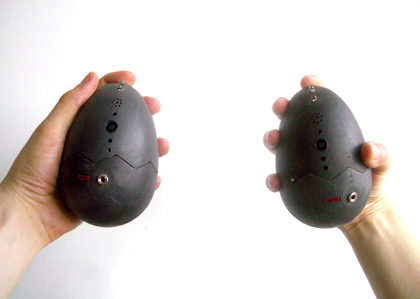
MobileFeelings II (2001-4). Sommerer & Mignonneau. Developed at IAMAS Institute of Advanced Media Arts and Sciences, Gifu, Japan. Sponsored by France Telecom Studio Creatif.
"Scientists often have fantastic brains but they don't always see the social relevance of what they do"
Interview with Christa Sommerer
Christa Sommerer (AT) and Laurent Mignonneau (FR) are internationally renowned media artists and researchers who have been collaborating since 1992. They explore and develop interactive systems and physical interfaces that are usually highly conceptual and innovative. MobileFeelings is a recent artistic project by Sommerer & Mignonnau that consists of wireless objects that let people communicate through virtual touch and body sensations including smell and sweat. The artwork was exhibited at DEAF (Dutch Electronic Art Festival) in Rotterdam where Sebastian Campion met with Christa Sommerer for a talk about their work and the challenges of today's' media-artists. DEAF November, 14 2004.
My first encounter with you and your work was at my first visit to Ars Electronica in 1999. I remember being amazed when I discovered that you had already been showing work there for a number of years because you and Laurent were both young. 5 years later you are still young but when you recently criticized the state of media art - for being too formalistic - it made me realize that you are now like veterans on the media art scene, which seems to get more youthful every year.
I don't realize this myself but I think as soon as you have worked for a long time continuously in a field you become a reference point. In a way it is good, but it is also dangerous because you don't want to be only a reference point. Most artists from our generation are still very active and are still pushing the boundaries but a lot of what young media artists are doing these days are recycling ideas, which is sometimes boring... you know, to see yet another gesture based interface and so on. Maybe it is cool for youngsters to discover and to play with this kind of software, but I think it is more interesting to go beyond that and instead explore new senses or concepts.
Has media-art gone from being underground to mainstream?
Yes, I mean it has been kind of institutionalized, simply because there are more schools teaching these technologies and there are more publications etc. It is a good trend of course, but it should not lead to a total establishment of the field. I find that a certain openness and risk-taking is necessary.
You and Laurent have been based in Japan for a number of years developing your artworks within a corporate research environment. What kind of freedom did you have and what expectations were you met with?
We used to work 7 years at the ATR Advanced Telecommunications Research Center in Kyoto Japan, which is not really a corporation but a basic research lab. Of course, the agenda was to inspire the other scientists by developing interfaces that were maybe slightly crazy or unusual but still sort of fed the research process and led to some prototype systems that can find applications in media industries and entertainment. I personally find it very satisfying to be a part of such a process because at some point we could see how our ideas became part of someone else's research or product as well. I think the idea of artists working as researchers is important because as soon as artworks involve and develop some advanced technology there is also a research process taking place. In the typical case, artists show the final project but do not make the research process transparent however, in the ideal case, I think there should be some transparency of how the artist has reached this final product and how it also relates to other works in this field and what kind of new knowledge has been created in the process. For each work that we do we also try to write a research paper where we explain exactly how we created this work, how the interface technology and the software works, and how this system relates to other works in this area. We attempt to publish the work in a scientific magazine or a scientific conference proceeding in addition to show it at media art events and festivals or art museums.
So, in general your artworks are not constrained to the art scene?
It's very important for us not only to show our work at art festivals, museums and galleries but also to try to contribute to the research community, for example in HCI or telecommunications research. Not only in terms of inventing new technologies or interfaces but also through inventing systems that have a slightly critical or unusual angle on technology. Scientists often have fantastic brains but they don't always see the social relevance of what they do, so I think it is very important that artists are there to look at technology from a more social or cultural point of view.
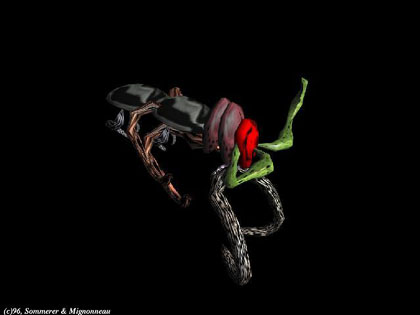
Genma, Genetic Manipulator (1996)
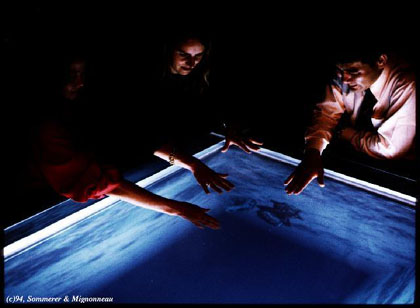
A-Volve, Interactive Environment (1994/95)
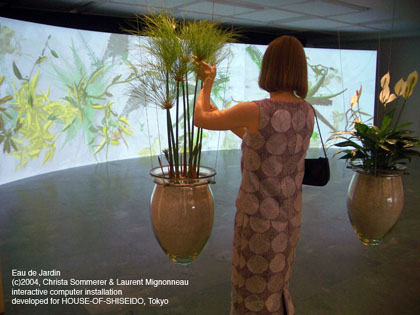
Eau de Jardin, Interactive Installation (2004)
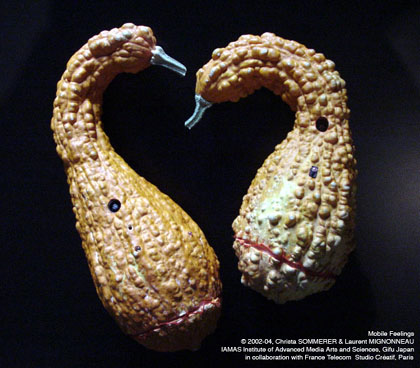
Mobile Feelings - first version, Wireless communication objects (2002/03)
What is your working process like as a duo? How do you develop your ideas conceptually and practically?
Of course, we discuss a lot and develop the concepts together and try to evolve our ideas further based on previous work. So, the conceptual part is done together but when it comes to the technical realization it is Laurent who brings in the knowledge about latest technologies and programming techniques. Also, when it comes to design - for example the Bluetooth devices that we use in Mobile-Feelings, Laurent did a lot of research on micro-sensors and the communication technology that transmit touch data over mobile phone networks.
Given your interest in artificial life - which has often characterized your work - did you ever consider doing real-life genetic engineering or in any way getting into Bio-Art?
Not so much, it is a little too one-dimensional and too flat to exactly reproduce what scientists are doing and a lot of the work we see in this area lacks a transformative aspect that goes beyond the naïve and anecdotal. Having studied biology myself, I am not so fascinated about recreating exactly the same metaphors as scientists and then call it art, just because I happen to be an artist; I consider that too simplistic. This also would solidify the old categories of what the artist should do and what the scientist should do, a notion that needs to be overcome to create new types of creators that go beyond these categories. At this moment we are very interested in Nano-technology and extremely small scale bio or chemical sensors that can be integrating into a body. Our work in Nano-technologies at this moment is conceptual but we are beginning to work with these systems. In 2002 we developed the artwork NanoScape for an exhibition in Germany called Science+Fiction. It is a Nano-sculpture that tries to make the invisibility nature of the Nano-world visible through touch.
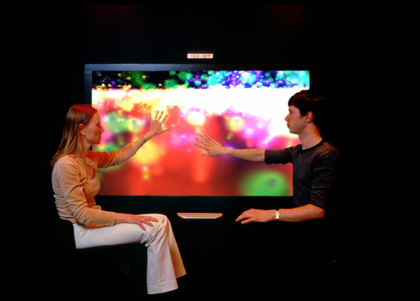
HAZE Express (1999). Interactive Installation.
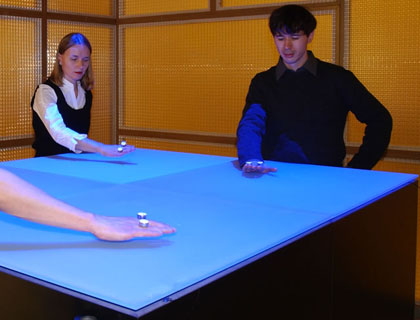
Nano-scape, Invisible Interactive Sculpture (2002)
Do you expect Nano-technology to open up a new conceptual direction for your work?
Yes. On one hand, it serves as an inspiration to make artworks and on the other hand I think we can contribute to the whole field by inventing new sensors and interactive systems. It is a matter of not only being inspired by technology but also to help change it and transform it. Right now, I think new technologies are very much going into the wrong purposes. You know, a lot of the sensors and the things we have seen over the past 10 years are now being part of military use. If you look at what someone like Steve Mann did 10 years ago - he was constantly connected to the internet wearing a headset and all his data input would be fed directly to a database or streamed on-line - I mean, this has become part of military reality bright now. The soldiers in Iraq look exactly like what Steve Mann developed as an art project 10 years ago! I think a lot of the things that artists have developed over the years are unfortunately very much politically used for the sake of pseudo-safety. I find it very scary.
Whenever we use digital communication technologies we accept to give up some of our privacy. Mobile Feelings is addressing this issue by integrating senses into wireless communication objects that could also be seen as mobile phones. Are you concerned about the possible misuse of your own work?
Yes, I think whatever you do, whatever you develop in terms of technology these days can be used for a negative purpose as well. The eggs that we use in Mobile Feeling, you know, of course you can use them for exchanging heart beats and having nice emotions but you can also use them as lie detectors - as a complete control mechanism to see whether a person is telling the truth or if he/she is excited or where exactly he/she is and in what kind of emotional state he/she is in. You can take any technology also in the opposite direction. The challenge for the media artist is to make us aware of this and to help shape the technologies into a creative, imaginary, positive and peaceful direction that benefit human society.
Christa Sommerer & Laurent Mignonneau: www.iamas.ac.jp/~christa/index.html
- Sebastian Campion.
|
 |
|